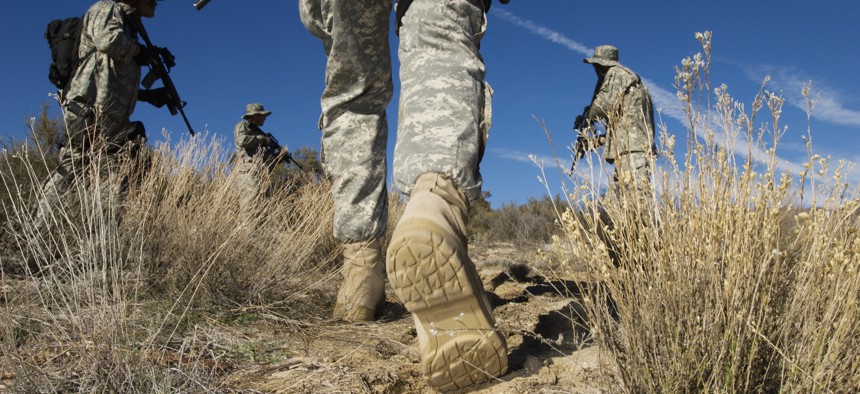sponsor content What's this?

Accelerating Procurement Key to Maintaining Land Warfare Superiority, Experts Say
With the U.S. Army shifting priorities to address future land warfare threats, it must apply lessons from Iraq and Afghanistan to keep its technological edge.
Presented by
DRS Technologies

In its stated aim of shifting personnel and resources toward the Pacific, the Department of Defense may be taking on undue risk by overlooking the continued importance of ground combat operations in today’s global security landscape, top military leaders say. At a post-AUSA event hosted by Defense One in Washington, D.C., U.S. Army officials suggested that without investments in ground force modernization, the U.S. could be in danger of ceding some measure of technological superiority to its adversaries.
With the room packed shoulder-to-shoulder with military brass, AUSA convention-goers, and DoD press corps — all catching their breath after a long day on the showroom floor — Defense One executive editor and panel moderator Kevin Baron framed the problem facing today’s U.S. Army:
“We all know the story: the wars in Iraq and Afghanistan ended, we were never going to do land warfare again — so said [former Secretary of Defense] Gates — and nobody asked [Russian President] Vladimir Putin about that. And so here we are trying to correct the correction, trying to build a ground force that is agile and flexible on a smaller budget.”
Joining Baron were Lt. Gen. Ben Hodges, the U.S. Army’s Commander in Europe, Col. Steven Sliwa, director of the Army’s Rapid Equipping Force (REF), and Paul Scharre, senior fellow and director of the 20YY Initiative at the Center for a New American Security (CNAS).
Lt. Gen. Hodges — who inherits a post previously held by Gen. Dwight Eisenhower — was quick to emphasize that Russian policy toward Crimea, Ukraine, and Syria is guided more so by historical context than Putin’s own political ambitions. “This is not about Putin,” he stated, “this is about how Russia sees itself in the world and the way it has attempted to assert itself and take control of its sphere, its zone, of influence.”
With the Russian economy and identity re-emerging after decades of post-Soviet malaise, Hodges stressed that U.S. policymakers and strategic planners must take into account the possibility that Moscow’s realpolitik streak may last decades. Hodges warned that the U.S.’s dwindling ground forces in Europe may pose a strategic risk to its interests and those of its NATO allies.
The difficulty is, with sequestration handcuffing the DoD budget and a second BRAC round politically dead in the water, U.S. Army Europe can’t depend on new deployments anytime soon. If the Army can’t get bigger, it has to get smarter. According to CNAS’s Paul Scharre, one way to do that is by reforming the acquisition process to make it more agile.
With the technology landscape evolving quickly, argued Scharre, DoD needs the capability to recognize demand for immediate solutions to mission-critical needs, invest in rapid prototyping, and deliver those solutions quickly to those in need. Citing the example of the MRAP Task Force, Scharre noted that future initiatives can draw upon past successes: “Institutionalizing tools that enable you to compress that time horizon is really fundamental.”
During the height of the wars in Iraq and Afghanistan, roadside bombs known as improvised explosive devices (IEDs) were claiming the lives of dozens of U.S. men and women in uniform each month. Recognizing the immediate needs of U.S. forces on the ground, then-Secretary of Defense Robert Gates authorized the task force to fast-track procurement of commercially-available armored vehicles to better protect U.S. forces. Within three years, the U.S. Army and Marine Corps were able to put over 27,000 MRAPs into the field. Gates later wrote that, unlike much of DoD’s procurement apparatus, the MRAP Task Force “truly saved the lives and limbs of U.S. troops.”
It’s these types of high-demand, high-visibility challenges that will continue to drive mission priorities at the Rapid Equipping Force (REF), stated its director, Col. Steven Sliwa. “When you look at the challenge we faced in Iraq and Afghanistan -- for instance, the impact the IED was making -- if there’s a tool the adversary is using, and it’s something the nation is focused on, that’s where we’ll be focusing: trying to get to the next solution.”
Sliwa said the Army needs “anything that is integrated or connected.” He further emphasized that DoD’s ability to identify viable commercially-available technologies is key to maintaining a robust accelerated procurement capability. For instance, the gunshot detection technologies the Army currently uses to pinpoint the location of enemy snipers is one such product of public-private partnership. Said Sliwa, gunshot detection “was developed through the REF and is available on virtually every vehicle we procure. And we achieved it by working with industry to get those kinds of things onto the battlefield without going through the full developmental process.”
Nevertheless, the Army’s current approach to developing and procuring combat systems -- one tested over thirteen years of operations in the Middle East -- will likely undergo significant change as the department continues to de-prioritize counterinsurgency operations in favor of a more conventional land warfare concept.
Despite continuing uncertainty surrounding Army budgets and force sizes, there were subtle hints on display at AUSA that the U.S. Army and its defense hardware suppliers were already working to respond to the new threat landscape. Noted Baron, “There were a lot more things in ‘forest green’ this time around, and a lot fewer in ‘desert tan.’”




